An Analysis of the Instability Conditions and Water Vapor Transport Characteristics during a Typical Rainstorm in the Tarim Basin
Abstract
:1. Introduction
2. Materials and Methods
2.1. Data Introduction
2.1.1. Study Area
2.1.2. Ground Observation Data
2.1.3. Reanalysis Data
2.1.4. Satellite Data
2.2. Model and Methods
2.2.1. Water Vapor Flux
2.2.2. Moist Potential Vorticity
2.2.3. HYSPLIT
3. Results
3.1. Rainfall Overview
3.2. Weather Situation and Dynamic Mechanism
3.3. Water Vapor Transport and Budget Characteristics
3.4. Mesoscale Convective Cloud Evolution
3.5. Thermal Structure and Instability Conditions
4. Conclusions and Discussion
- (1)
- The rainstorm in the Tarim Basin occurred under the background of large-scale circulation with the distribution of a “uniform double body” of the South Asian High at 200 hPa to “high in the west and low in the east”. The upper westerly jet extended south; the upper Iran Ridge, the Central Asian Low Trough and the Baikal Lake Ridge extended at 500 hPa; and the southard extension of the low trough at 700 hPa combined with wind shear led to the rainstorm process. The coupling of the high, middle and low levels of the jet stream and the strong vertical upward movement provided favorable dynamic conditions for the rainstorm. The variation and movement of the TBB intensity are in good agreement with the occurrence and development of heavy rainfall in the basin.
- (2)
- The rainstorm water vapor mainly comes from the Mediterranean Sea, the Arabian Sea, the Bay of Bengal and Central Asia, and it reaches the Tarim Basin along four paths: westward, east-to-west, west-to-east, and southwest and south. At 600–500 hPa, there is a better water vapor channel, and the strong convergence center is located at 500 hPa. Water vapor is mainly imported from 600 to 300 hPa in the west, from 500 to 400 hPa in the south and from 850 to 700 hPa in the east, and outflow is imported from 600 to 300 hPa in the east.
- (3)
- Heavy rainfall occurs in the area with large θse gradient, and the rain band range of heavy rainfall has a good correspondence with the unstable region reflected in the vertical direction of θse. The T-lnp map reflects strong unstable stratification in the vertical direction of the rainstorm area. The intensity variation and movement direction of the negative MPV at a low level have a strong indication on the fall area and occurrence and the development of a rainstorm in the basin, and the superposition of positive and negative MPV regions at vertical height is conducive to the occurrence and development of a rainstorm.
Author Contributions
Funding
Institutional Review Board Statement
Informed Consent Statement
Data Availability Statement
Acknowledgments
Conflicts of Interest
Appendix A
References
- Yuan, Y.F.; Zhai, P.M. Latest understanding of extreme weather and climate events under global warming and urbanization influences. Trans. Atmos. Sci. 2022, 45, 161–166. [Google Scholar]
- Sun, G.Q.; Wu, Y.; Li, B.L.; Guo, Y. Impacts of global warming on ecology and meteorology and the related physical mechanisms, evaluation and prediction. Front. Phys. 2022, 10, 1035. [Google Scholar] [CrossRef]
- Zeng, J.; Guo, F.; Zhao, C.; Sun, Z.Y.; Zhao, Y.J. Climate change of small oases in the southern margin of Taklimakan Desert in recent 50 years. Arid Zone Geogr. 2014, 37, 948–957. [Google Scholar]
- Han, Y.H.; Ma, Z.G.; Yang, Q.; Pan, Z.H. Changing characteristics of daytime and nighttime precipitation in Xinjiang under global warming. Clim. Environ. Res. 2014, 19, 763–772. [Google Scholar]
- Wang, S.P.; Jiang, F.Q.; Wu, X.B.; Hu, R.J. Temporal and spatial variability of the extreme precipitation indices overthe arid regions in Northwest China from 1961 to 2010. J. Glaciol. Geocryol. 2014, 36, 318–326. [Google Scholar]
- Yang, L.M. Climate Change of Extreme Precipitation in Xinjiang. Acta Geogr. Sin. 2003, 58, 577–583. [Google Scholar]
- Dai, X.G.; Ren, Y.Y.; Chen, H.W. Multi-scale feature of climate and climate shift in Xinjiang over the past 50 years. Acta Meteorol. Sin. 2007, 6, 1003–1010. [Google Scholar] [CrossRef]
- Wang, C.H.; Li, J.; Li, X.L.; Xu, X.G. Analysis on Quasi periodic Characteristics of Precipitation in Recent 50 Years and Trend in Next 20 Years in China. Arid Zone Res. 2012, 29, 1–10. [Google Scholar]
- Chen, C.Y.; Zhao, K.M.; Ablikim, A.; Li, N.; Yu, B.X. Temporal and spatial distributions of hourly rain intensity under the warm background in Xinjiang. Arid Land Geogr. 2015, 38, 692–702. [Google Scholar]
- Wang, J.; Li, R.Q.; Huang, Y.; Zhao, K.M.; Li, J.G.; Zhou, Y.M. Cause of a Rare Rainstorm in the West of Southern Xinjiang in 2013. J. Arid Meteorol. 2015, 33, 910–917. [Google Scholar]
- Jin, C.; He, Q.; Huang, Q. Effect of Water Vapor Transport on a Typical Rainstorm Process in the Arid Region of Southern Xinjiang: Observations and Numerical Simulations. Remote Sens. 2023, 15, 4082. [Google Scholar] [CrossRef]
- Lv, X.S.; Zhou, Y.M.; Yu, X.J.; Yu, B.X.; Wang, X. Temporal and Spatial Variation Characteristics of Rainstorm Flood Disaster Loss in Xinjiang during 1961–2019. Desert Oasis Meteorol. 2021, 15, 42–49. [Google Scholar]
- Wang, X.Q.; Wang, X. Spatial distribution and temporal variation characteristics of rainstorm flood disasters with different intensities in southern Xinjiang from 1980 to 2019. J. Glaciol. Geocryol. 2021, 43, 1818–1828. [Google Scholar]
- Shen, X.Y.; Sha, S.; Liu, L.K.; Li, X.F. 2018: Research progress on atmospheric multiscale interaction. Torrential Rain Disasters 2018, 37, 197–203. [Google Scholar]
- Chen, B.Y.; Min, J.Z. A study on the evolution of vortex system and multi-scale interaction mechanism during the “7·19” rainstorm in North China. J. Trop. Meteorol. 2020, 36, 85–96. [Google Scholar]
- Yang, L.M.; Zhang, Q.Y. Circulation characteristics of interannual and interdecadal anomalies of summer rainfall in north Xinjiang. Chin. J. Geophys. Chin. Ed. 2007, 50, 412–419. [Google Scholar]
- Zhang, Q.; Qian, Z.A.; Chen, M.L. The further study about South Asia High in summer Ⅰ. Statistic analysis of relationship between it and precipitation distribution over Northwest China. Plateau Meteorol. 1997, 1, 53–63. [Google Scholar]
- Zhao, Y.; Wang, Q.; Huang, A.N. Relationship between Iran High Pattern of South Asia High and Summer Precipitation in Xinjiang. Plateau Meteorol. 2018, 37, 651–661. [Google Scholar]
- Zhang, Y.; Kuang, X.; Guo, W.; Zhou, T. Seasonal evolution of the upper-tropospheric westerly jet core over East Asia. Geophys. Res. Lett. 2006, 33, L11708. [Google Scholar] [CrossRef]
- Zhao, Y.; Wang, M.; Huang, A.; Li, H.; Huo, W.; Yang, Q. Relationships between the West Asian subtropical westerly jet and summer precipitation in northern Xinjiang. Theor. Appl. Climatol. 2014, 116, 403–411. [Google Scholar] [CrossRef]
- Liu, Y.Y.; He, J.H.; Wang, Q.Q. Analysis of temporal spatial features and circulation characteristics of summer precipitation in Xinjiang. J. Nanjing Inst. Meteorol. 2006, 29, 24–32. [Google Scholar]
- Yang, L.M.; Shi, Y.G.; Tang, H. Characteristic of atmospheric circulation and water vapor spring precipitation anomaly in Xinjiang. Plateau Meteorol. 2010, 29, 1464–1473. [Google Scholar]
- Yang, L.M.; Guan, X.F.; Zhang, Y.X. Study on atmospheric circulation characteristics of precipitation anomalies in arid region of Central Asia. Arid Zone Res. 2018, 35, 249–259. [Google Scholar]
- Lu, X.; Zhao, Y.; Wang, T.Z. Analysis on the circulation differences of summer rainfall over Xinjiang. Desert Oasis Meteorol. 2021, 15, 84–90. [Google Scholar]
- Ma, Q.; Zhang, J.; Game, A.T.; Chang, Y.; Li, S. Spatiotemporal variability of summer precipitation and precipitation extremes and associated large-scale mechanisms in Central Asia during 1979–2018. J. Hydrol. X 2020, 8, 100061. [Google Scholar] [CrossRef]
- Li, M.J. Analysis of Precipitation Distribution over Xinjiang and the Dynamic Characteristics of Meso and Mirco Scale Precipitation. Master’s Thesis, Nanjing University of Information Science and Technology, Nanjing, China, 4 June 2014. [Google Scholar]
- Sun, Y.S. The Relationship between Low-Level Jet and Heavy Precipitation in Xinjiang. Master’s Thesis, Nanjing University of Information Science and Technology, Nanjing, China, 10 June 2019. [Google Scholar]
- Yang, X.; Zhou, H.K. Analysis of the Difference between Rainstorm Accompanied by Easterly Low-level Jet in Tarim and Rainstorm without Easterly Low-level Jet in Tarim in Southern Xinjiang. Plateau Meteorol. 2023, 42, 1492–1503. [Google Scholar]
- Feng, Y.; Niyazi, A.; Yunusi, R. Cause Analysis of an Extreme Heavy Rainstorm Process on July 31 of 2018 in Hami of Xinjiang. J. Arid Meteorol. 2021, 39, 426–435+456. [Google Scholar]
- Zeng, Y.; Yang, L.M. 2017: Comparative analysis on mesoscale characteristics of two severe short-time precipitation events in the west of southern Xinjiang. Torrential Rain Disasters 2017, 36, 410–421. [Google Scholar]
- Zhang, Q.; Zhu, B.; Yang, J.; Ma, P.; Liu, X.; Lu, G.; Wang, Y.; Yu, H.; Liu, W.; Wang, D. New characteristics about the climate humidification trend in Northwest China. Chin. Sci. Bull. 2021, 66, 3757–3771. [Google Scholar] [CrossRef]
- Zhang, Q.; Yang, J.; Duan, X.; Ma, P.; Lu, G.; Zhu, B.; Liu, X.; Yue, P.; Wang, Y.; Liu, W. The eastward expansion of the climate humidification trend in northwest China and the synergistic influences on the circulation mechanism. Clim. Dyn. 2022, 59, 2481–2497. [Google Scholar] [CrossRef]
- Zhang, J.L.; Li, H.Q.; Tang, H. Preliminary analysis of the synergistic influence of westerly wind and indian monsoon on rainstorm over Tarim Basin. Trans. Atmos. Sci. 2023, 46, 242–258. [Google Scholar]
- Wang, C.X.; Deng, L.T.; Fan, G.Z.; Li, Z.C.; Zhou, D.W. Diagnostic Analysis of Convective Symmetric Instability During a Banded Precipitation Process in North China. Meteor. Mon. 2018, 44, 1518–1528. [Google Scholar]
- Sun, J.S.; Tao, Z.Y. Some Essential Issues Connected with Severe Convective Weather Analysis and Forecast. Meteor. Mon. 2012, 38, 164–173. [Google Scholar]
- Zhang, J.C.; Wang, H.X.; Tao, Z.Y. Statistical analysis of predicting skill of Convective Available Potential Energy. Torrential Rain Disasters 2014, 33, 290–296. [Google Scholar]
- Ye, L.; Zhang, M.; Zhao, D.C.; Xu, S.Y.; Shao, X.F. The statistical analysis of thunderstorm convective available potential energy in East China. J. Anhui Agric. Sci. 2015, 43, 160–162+285. [Google Scholar]
- Liu, J.; Zhou, Y.M.; Yang, L.M.; Zeng, Y.; Liu, W. The Instability and its Trigger Mechanism of Extreme Precipitation Event in the Yili River Valley on 31 July 2016. Chin. J. Atmos. Sci. 2019, 43, 1204–1218. [Google Scholar]
- Li, J.N.; Pan, X.B.; Zang, Z.L.; Zhao, D.C.; Min, S. Diagnostic analysis of moist potential vorticity for a rainstorm in North China. Torrential Rain Disasters 2016, 35, 158–165. [Google Scholar]
- Xiao, Y.Q.; Shen, X.Y.; Zhang, X.L.; Yang, Y.Y.; Zhang, J.R.; Zhang, C.; Li, X.F. Diagnostic analysis of moist potential vorticity for two local rainstorm events on the eastern foot of Helan Mountain. Torrential Rain Disasters 2020, 39, 148–157. [Google Scholar]
- Zhang, J.; Zhou, Y.S.; Shen, X.Y.; Li, X.F. Evolution of Dynamic and Thermal Structure and Instability Condition Analysis of the Extreme Precipitation System in Beijing-Tianjin-Hebei on July 19 2016. Chin. J. Atmos. Sci. 2019, 43, 930–942. [Google Scholar]
- Guo, D.M.; Pan, L.J.; Shi, Y.Q.; Hu, Q.Y.; Wu, L.R.; Liu, J.H.M.; Tao, J.L. Analysis of a Rare Autumn Rainstorm behind Cold Front in Xi’an. Plateau Meteorol. 2020, 39, 986–996. [Google Scholar]
- Liu, L.; Ran, L.K.; Zhou, Y.S.; Gao, S.T. Analysis on the Instability and Trigger Mechanism of Torrential Rainfall Event in Beijing on 21 July 2012. Chin. J. Atmos. Sci. 2015, 39, 583–595. [Google Scholar]
- Huang, X.; Zhou, Y.S.; Ran, L.K.; Ullah, K.; Zeng, Y. Analysis of the Environmental Field and Unstable Conditions on A Rainstorm Event in the Ili Valley of Xinjiang. Chin. J. Atmos. Sci. 2021, 45, 148–164. [Google Scholar]
- Ren, Z.H.; Zhao, P.; Zhang, Q.; Zhang, Z.F.; CAo, L.J.; Yang, Y.R.; Zou, F.L.; Zhao, Y.F.; Zhao, H.M.; Chen, Z. Quality Control Procedures for Hourly Precipitation Data from Automatic Weather Stations in China. Meteor. Mon. 2010, 36, 123–132. [Google Scholar]
- Xu, X.H.; Yu, X.; Zhu, Y.N.; Liu, G.H.; Dai, J. Cloud Microphysical Properties of a Tornado Revealed by FY-2G Geostationary Satellite. Plateau Meteorol. 2018, 37, 1737–1748. [Google Scholar]
- Trenberth, K.E. Climate diagnostics from global analyses: Conservation of mass in ECMWF analyses. J. Clim. 1991, 4, 707–722. [Google Scholar] [CrossRef]
- Wu, G.X.; Cai, Y.P.; Tang, X.J. Moist potential voriticity and slantwise vorticity development. Acta Meteorol. Sin. 1995, 4, 387–405. [Google Scholar] [CrossRef]
- Yu, Q.H.; Lv, Z.Y.; Li, Z.X.; Yao, Y. Analysis of Satellite Cloud Images and Dual-Polarization Radar Features of the 20 July, 2021 Zhengzhou Extreme Torrential Rain. Meteorol. Environ. Sci. 2022, 45, 102–111. [Google Scholar]
- Qin, D.Y. A Case Study of Meso-α-scale Convective System Shape Differences Using Filtering Analysis. Chin. J. Atmos. Sci. 2010, 34, 154–162. [Google Scholar]
- Wang, L.M.; Luo, H.B. The basic dynamic equations and the main properties of the saturated moist air. Acta Meteorol. Sin. 1980, 1, 44–50. [Google Scholar] [CrossRef]
- Zhang, M. The Study About the Rainstorm Forecast In Hohhot With the High Resolution Model Radiosonde Data. Meteorol. J. Inn. Mong. 2017, 5, 12–14+45. [Google Scholar] [CrossRef]
- Gu, T.H.; Du, X.L.; Li, L.; Zhang, Y.M.; Shao, G.Y. Statistical analysis of the environmental parameters of heavy rainfall in Southwest China based on sounding observation. Mid-Low Latit. Mt. Meteorol. 2022, 46, 27–32. [Google Scholar]
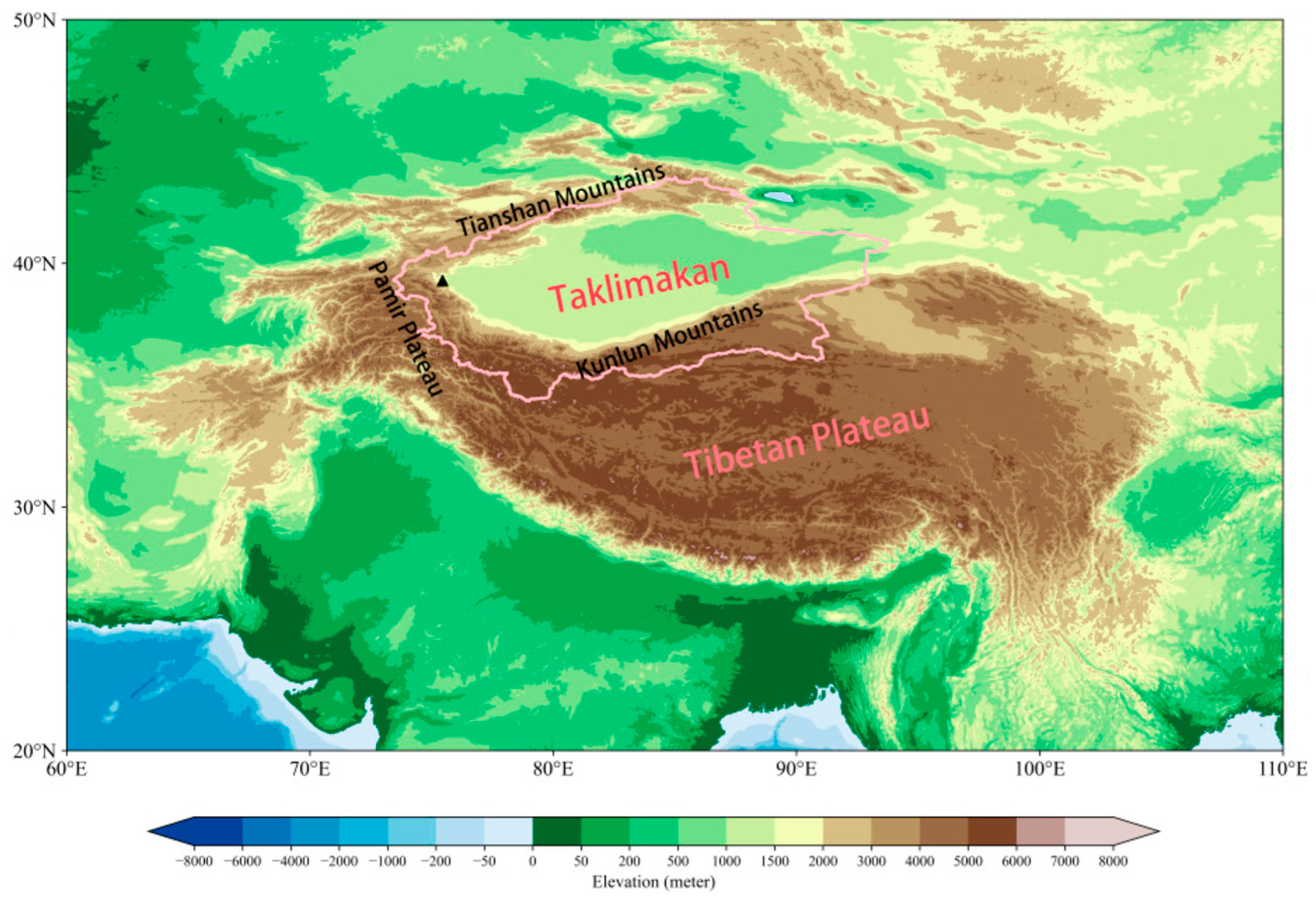
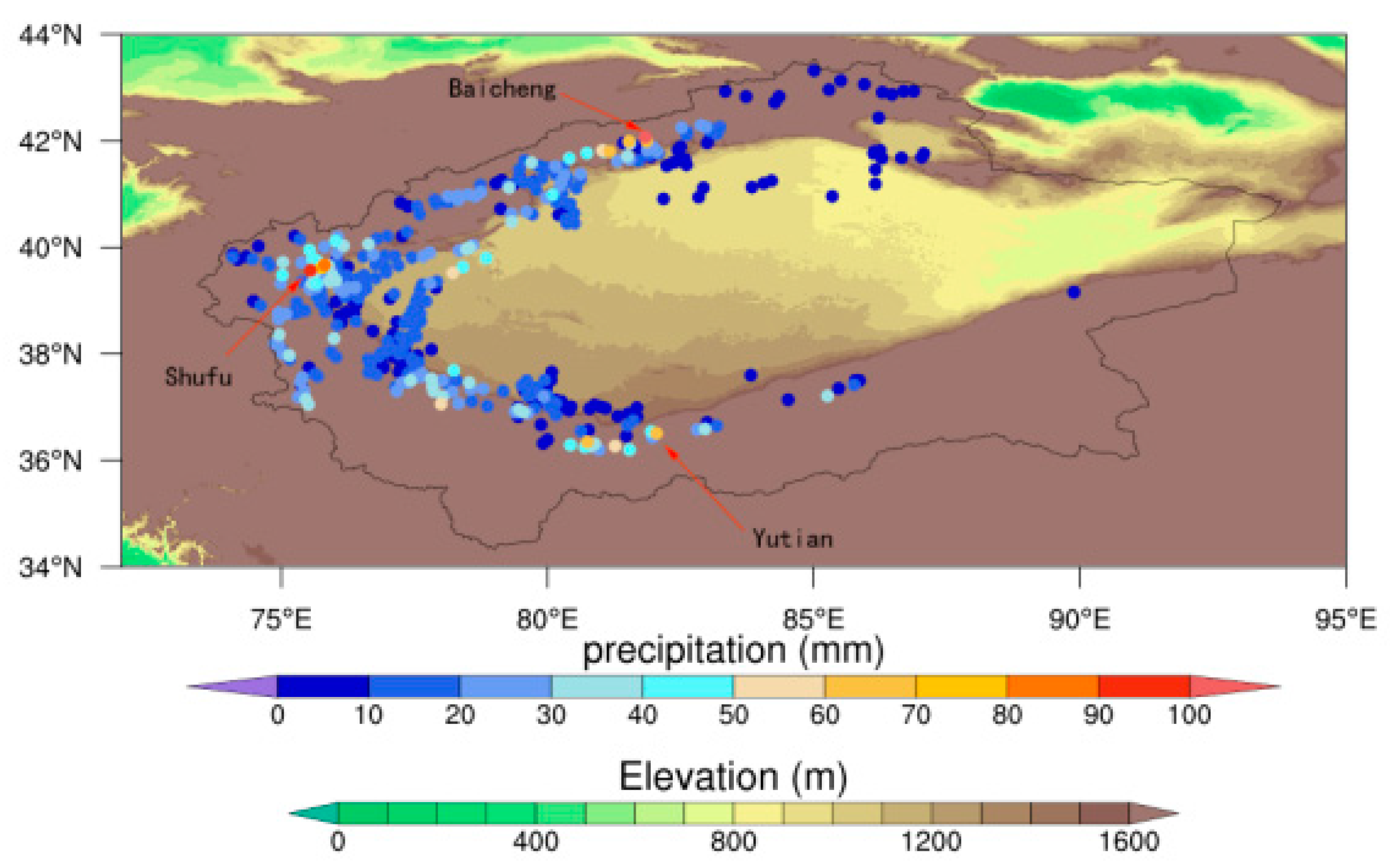



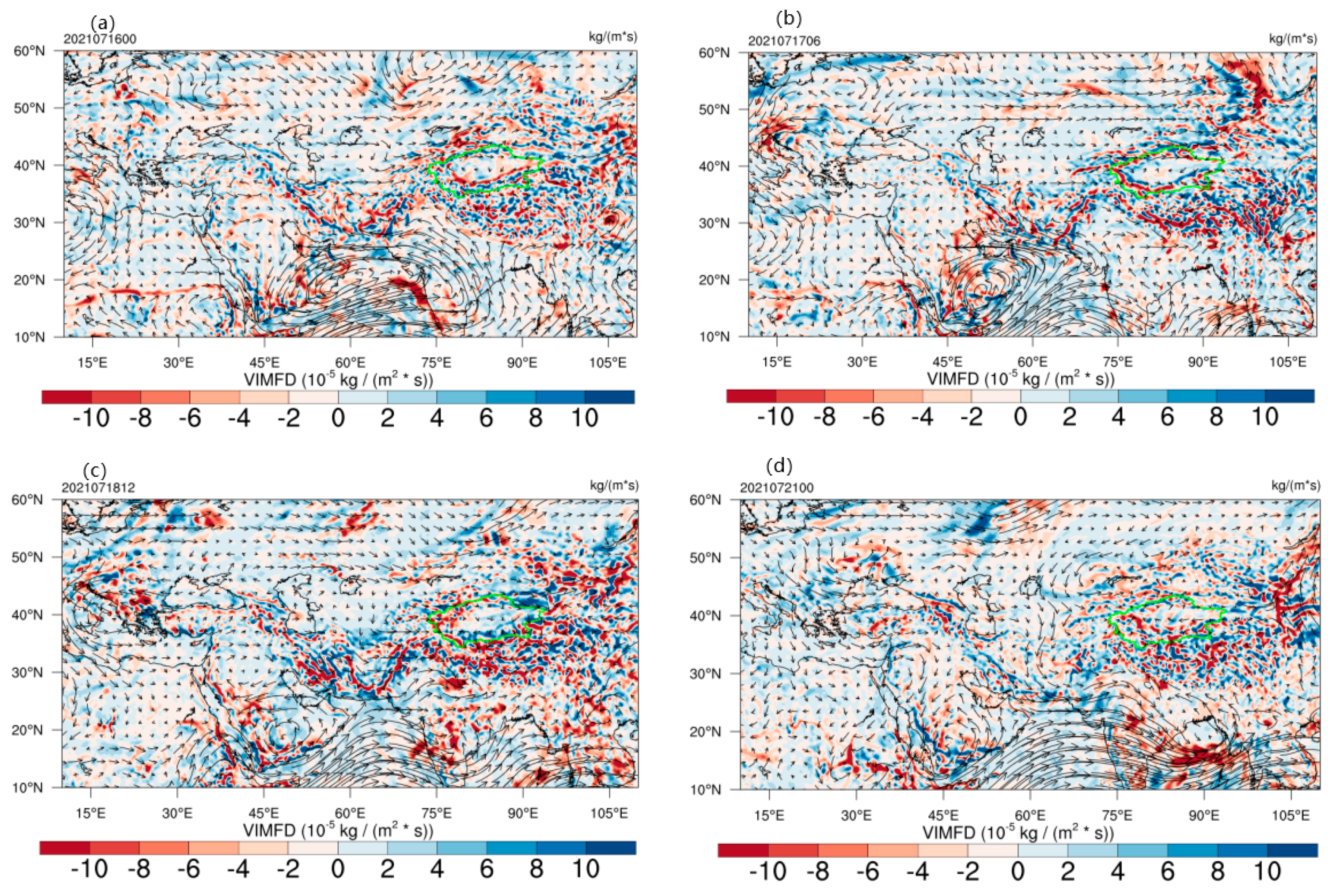


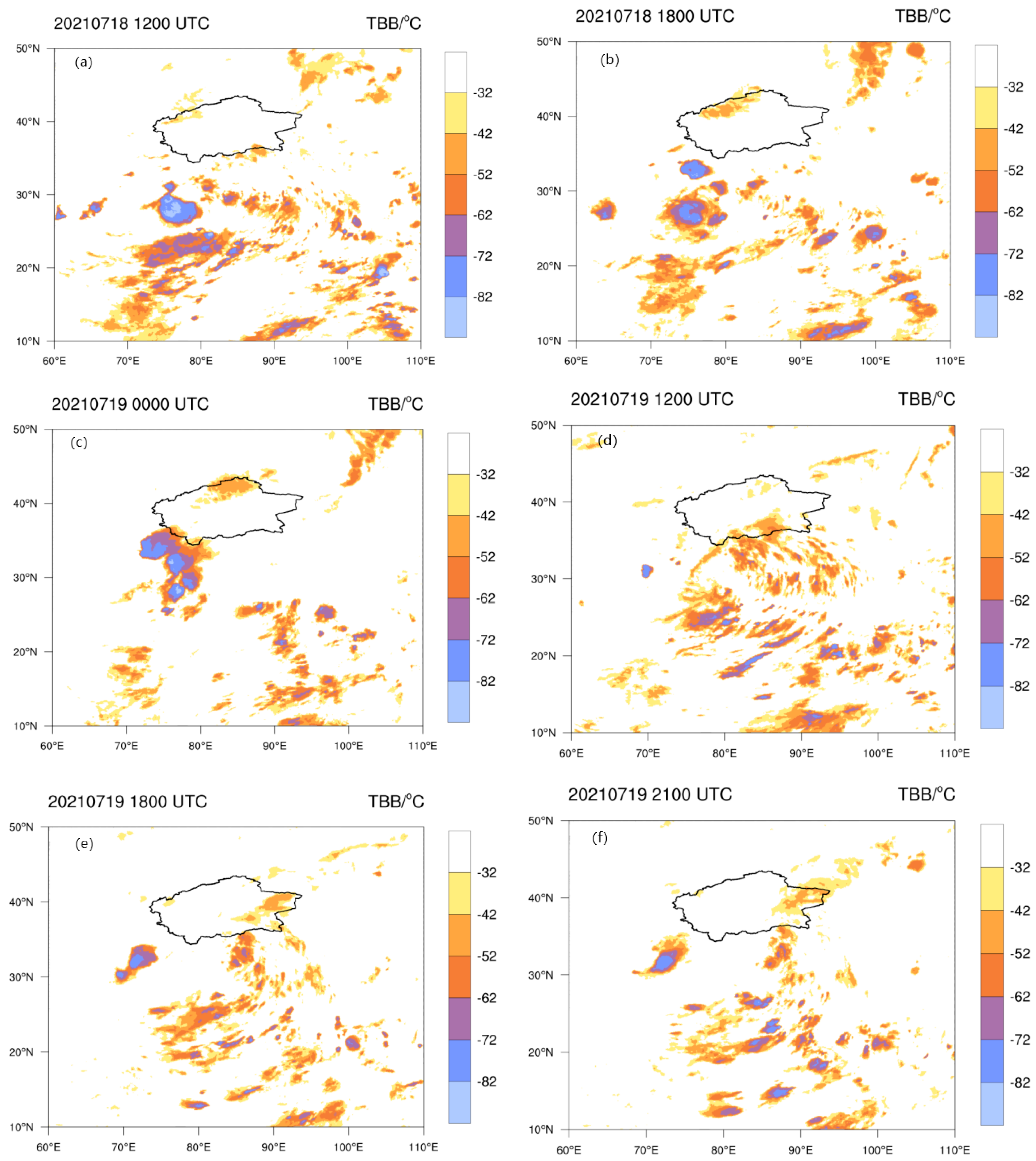

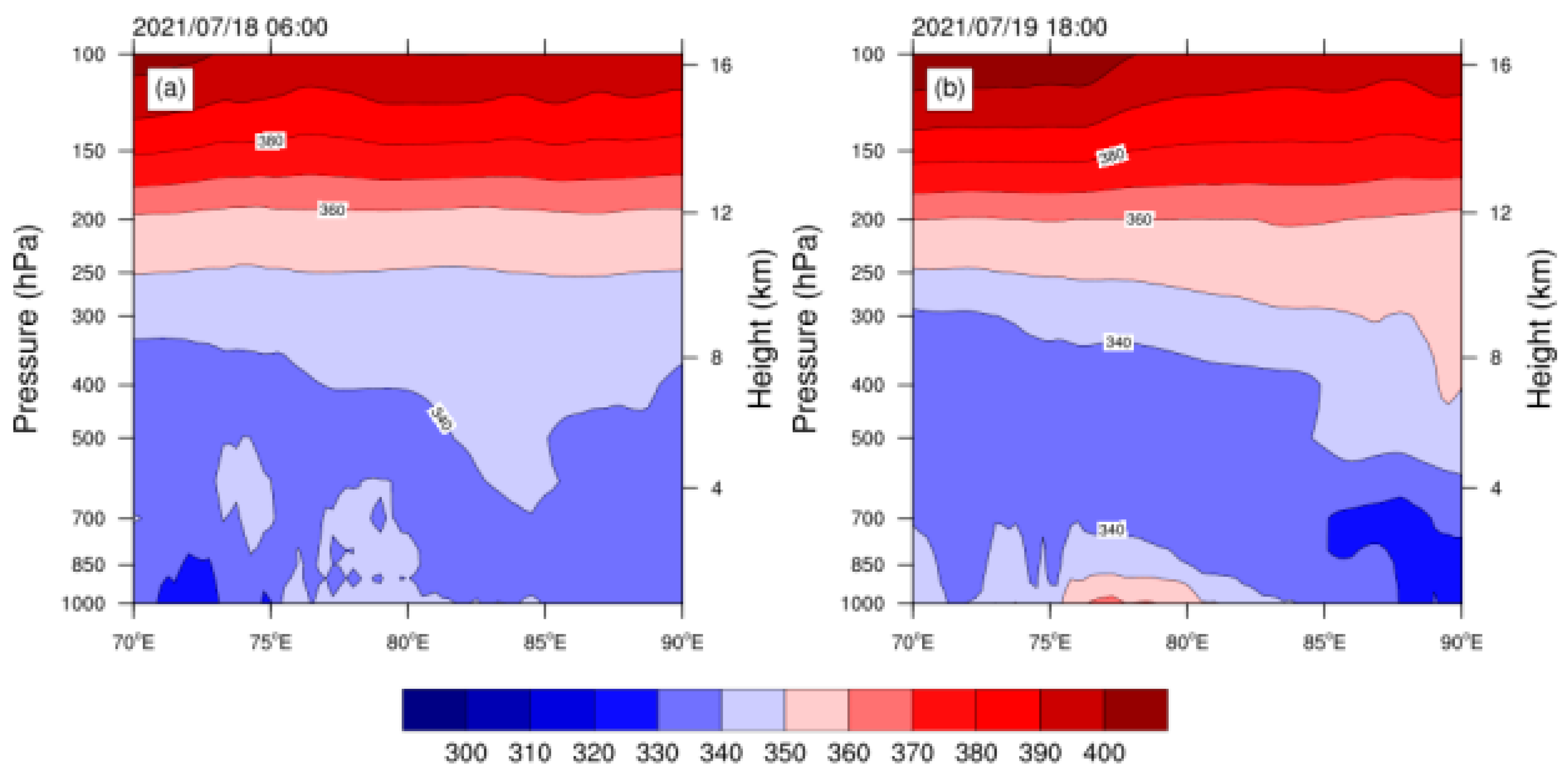

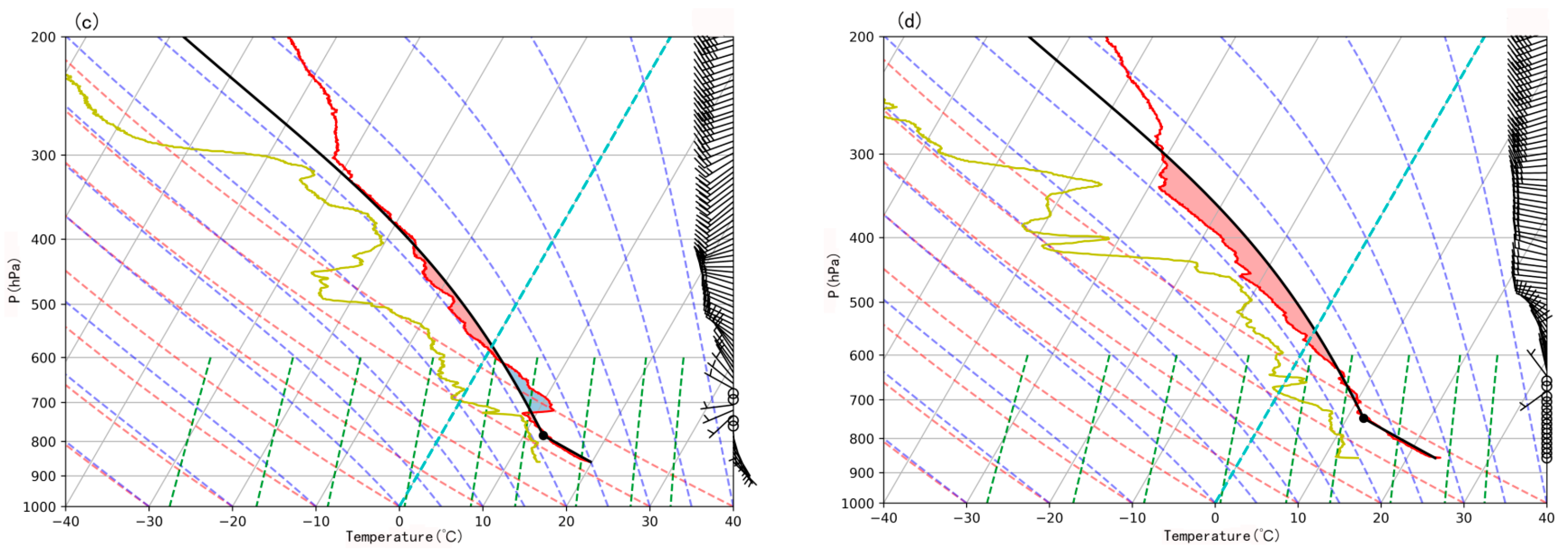
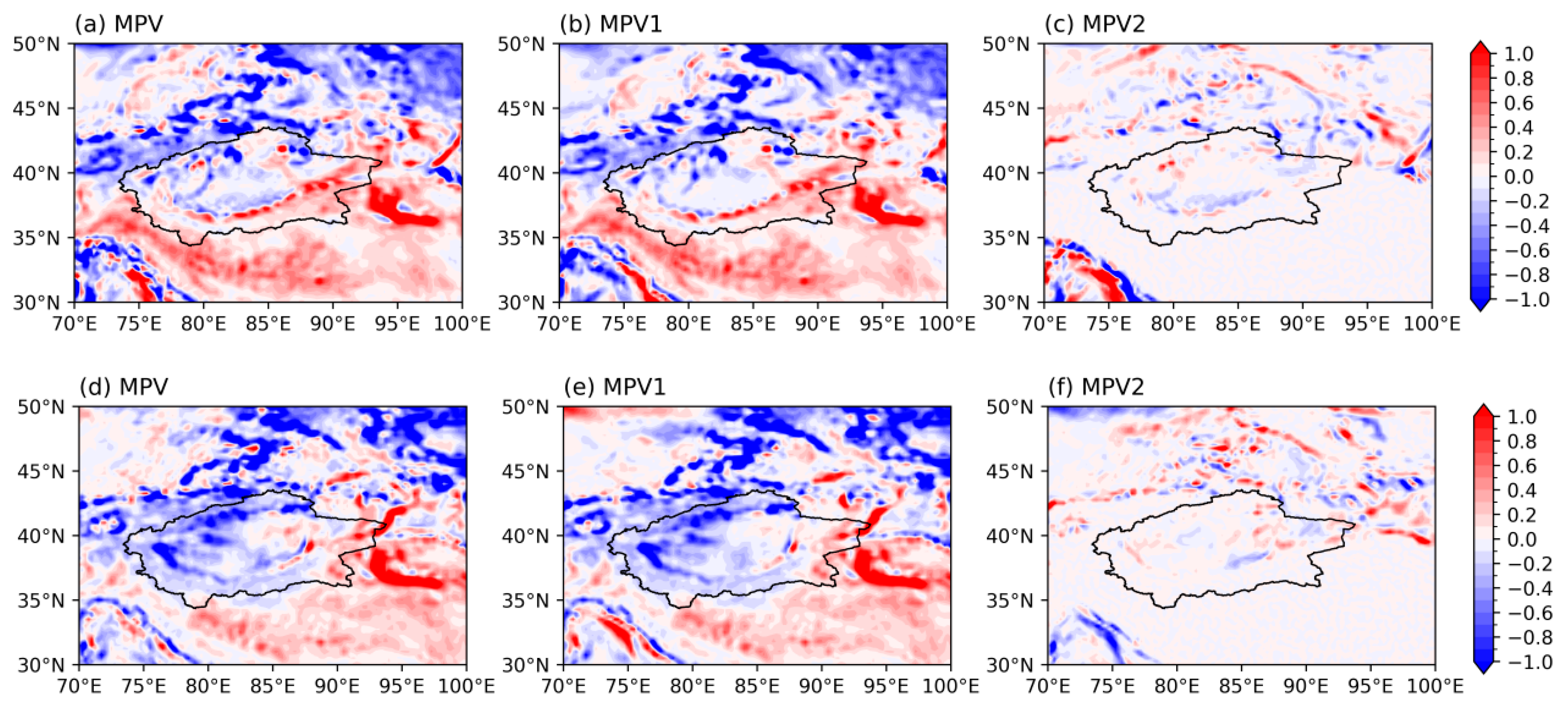

Disclaimer/Publisher’s Note: The statements, opinions and data contained in all publications are solely those of the individual author(s) and contributor(s) and not of MDPI and/or the editor(s). MDPI and/or the editor(s) disclaim responsibility for any injury to people or property resulting from any ideas, methods, instructions or products referred to in the content. |
© 2024 by the authors. Licensee MDPI, Basel, Switzerland. This article is an open access article distributed under the terms and conditions of the Creative Commons Attribution (CC BY) license (https://creativecommons.org/licenses/by/4.0/).
Share and Cite
Jin, C.; He, Q.; Huang, Q.; Chen, Z. An Analysis of the Instability Conditions and Water Vapor Transport Characteristics during a Typical Rainstorm in the Tarim Basin. Atmosphere 2024, 15, 210. https://doi.org/10.3390/atmos15020210
Jin C, He Q, Huang Q, Chen Z. An Analysis of the Instability Conditions and Water Vapor Transport Characteristics during a Typical Rainstorm in the Tarim Basin. Atmosphere. 2024; 15(2):210. https://doi.org/10.3390/atmos15020210
Chicago/Turabian StyleJin, Chen, Qing He, Qian Huang, and Ze Chen. 2024. "An Analysis of the Instability Conditions and Water Vapor Transport Characteristics during a Typical Rainstorm in the Tarim Basin" Atmosphere 15, no. 2: 210. https://doi.org/10.3390/atmos15020210
APA StyleJin, C., He, Q., Huang, Q., & Chen, Z. (2024). An Analysis of the Instability Conditions and Water Vapor Transport Characteristics during a Typical Rainstorm in the Tarim Basin. Atmosphere, 15(2), 210. https://doi.org/10.3390/atmos15020210





